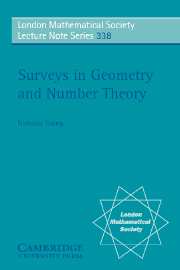Book contents
- Frontmatter
- Contents
- Preface
- Affine embeddings of homogeneous spaces
- Formal groups over local fields: a constructive approach
- Classification problems and mirror duality
- Birational models of del Pezzo fibrations
- Best Diophantine approximations
- Projectively dual varieties of homogeneous spaces
- Equivariant embeddings of homogeneous spaces
- Geometric quantization and algebraic Lagrangian geometry
Birational models of del Pezzo fibrations
Published online by Cambridge University Press: 07 May 2010
- Frontmatter
- Contents
- Preface
- Affine embeddings of homogeneous spaces
- Formal groups over local fields: a constructive approach
- Classification problems and mirror duality
- Birational models of del Pezzo fibrations
- Best Diophantine approximations
- Projectively dual varieties of homogeneous spaces
- Equivariant embeddings of homogeneous spaces
- Geometric quantization and algebraic Lagrangian geometry
Summary
Preliminaries
Acknowledgment. This review is a printed version of the talks given by the author in the University of Liverpool and the Isaac Newton Institute for Mathematical Sciences in spring of 2002, and organized by the London Mathematical Society. I express my gratitude to the Society for the kind support. I am especially grateful to Professor Vyacheslav Nikulin and Professor Thomas Berry for their close reading of the text. They helped me very much to prepare the final version of the paper.
Given an algebraic variety X, we can naturally attach some objects to it, such as its field of functions k(X), the essential object in birational geometry. Assuming classification to be one of the most important problems in algebraic geometry, we may be asked to describe all algebraic varieties with the same field of functions, that is, all varieties that are birationally isomorphic to X. Of course, ‘all’ is far too large a class, and usually we restrict to projective and normal varieties (though non-projective or non-normal varieties may naturally arise in some questions). Typically there are two main tasks:
A. Given a variety V, determine whether it is birational to another variety W.
B. Given that V and W are birational to each other, determine a decomposition of a birational map between them into ‘elementary links’, that is, birational maps that are, in an appropriate sense, particularly simple.
The rationality problem, i.e. to determine if a given variety is rational, is an essential example of task A.
- Type
- Chapter
- Information
- Surveys in Geometry and Number TheoryReports on Contemporary Russian Mathematics, pp. 122 - 157Publisher: Cambridge University PressPrint publication year: 2007
- 3
- Cited by

